
Pregnancy and Childbirth for the Historical Author
Things to consider…
- Be aware that many references have an agenda; history is rarely so simple
- Childbirth customs reflect society’s view of birth, sexuality, and women
- Beliefs and practices varied not only by time, but by locale, family and individual
- Trends overlapped; change occurred more rapidly in urban areas versus rural
- Be true to the physical experience of childbirth
- Be true to your characters
Ancient Times ~ Medieval to Seventeenth Century ~ Eighteenth Century ~ Late Georgian to Regency ~ The Victorian Era ~ Miscellaneous Topics ~ Bibliography


Attitudes and Developments
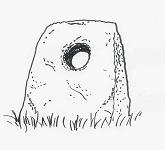
- Birth and death viewed in relation to cycles of the earth (planting/harvest), the moon, the tides
- Stones as womb/tomb, source of ancestral souls, magical powers
- View of woman as a “ploughed field” which can be barren or fertile
- Fear of evil spirits
- Influence of gods and goddesses
-
- Hathor, Meshkenet (Egyptian)
- Artemis/Diana, Eileithyia/Lucina (Greek, Roman)
- Influence of religion diluted in Greco-Roman world around 4-5th century BC by Hippocratic “rationalism”
- The “wandering womb”
- Baby starts labor, fighting his way out of womb; labor pains are just a reaction
Practices
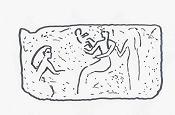
- Herbs, amulets, rituals with sacred stones, trees, waters
- Midwife assisted
- Egyptian births:
- Position: squatting or kneeling over two birthing bricks, or seated on a brick seat
- Greek/Roman:
- Birthing stools
- Midwife-assisted, but male doctors might be called in to advise
- Early instances of male control over childbirth, distrust of midwives
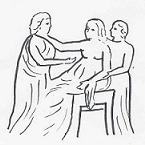
- Other cultures:
- Birth customs and traditions varied
- Upright birth postures predominate: standing, squatting, kneeling, sitting, possibly using pole, tree, rope or attendant for support
Sources
Please click on the links below to access the relevant entries in the Bibliography.
Banks, Amanda Carson, Birth Chairs, Midwives and Medicine
Demand, Nancy, Birth, Death, and Motherhood in Classical Greece
Engelmann, George J., Labor Among Primitive Peoples
Gelis, Jacques, History of Childbirth: Fertility, Pregnancy and Birth in Early Modern Europe
Ghalioungui, Paul, The Physicians of Pharaonic Egypt
Ghalioungui, Paul, Magic and Medical Science in Ancient Egypt
Soranus of Ephesus, Gynecology


Attitudes and Developments
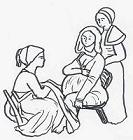
- Birth viewed as a natural event, trust in God and nature
- Birth was women’s province but…
- Conflict between ancient practices and the church
- Associations of midwifery with witchcraft
- Old superstitions gradually being Christianized
- Labor pain: women’s punishment for Eve’s sins
Practices
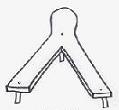
- Births managed by midwives
- Could be elected, the most trusted woman of her village
- Often the daughter of a midwife
- A very few received training from male doctors
- In some areas might be licensed through the local bishop
- Usually carried low case loads
- Unlikely to transmit puerperal fever
- Unlikely to experience many problematic births
- Worked as a public service, rewarded with gifts
- Later became paid for their work
- Influential in their communities
- Male doctors’ role:
- Wrote treatises instructing midwives
- Dealt with emergencies: “When a man comes, one or both must die”
- Birthing stool “reinvented”
- Herbs and amulets continued to be used, as time went on, also “birthing bags” with prayers and religious amulets
- Appeals to the Virgin Mary and St Margaret, other saints
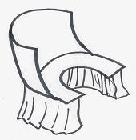
- Childbirth ritual:
- Husband goes “nidgeting”, calls midwife and “gossips”: female relatives and friends who will support the laboring woman
- Lying-in chamber/house prepared: keyholes stopped up, windows closed, curtains drawn, candles lit
- Dark, warm atmosphere to ward off chills (and protect from evil spirits)
- Caudle: warmed spiced wine or ale
- Birth positions varied regionally, also might use a birthing chair
- Often before hearth for warmth, straw on the floor to absorb fluids
- Not in bed (think about the mess)
- Female bonding
- Husband might help in case of emergency; his strength might be needed
- Midwife might “work” the woman’s private parts to speed dilation, use massage to aid delivery, sometimes pulled cord to deliver afterbirth
- Postpartum care:
- Child swaddled, protected from evil influences until baptism
- Breastfeeding might begin; upper class women might use wet-nurses
- Upper class women might foster babies out to wet-nurses
- “Lying-in”: recovery period of up to a month
- Some of “gossips” might stay to help with housework, other children
- Amongst wealthy, elaborate rituals of visiting, celebration, presents
- Lying-in period followed by “churching” of the mother
- Difficult cases:
- Slow labors sped by herbs, emetics, ergot of rye
- Some midwives had methods of “version” to turn a badly positioned baby
- Craniotomy using crotchet to save mother’s life
- Caesarean section known but rarely performed, usually to deliver child if mother had already died
- Forceps invented in early 17th century, family secret of the Chamberlens
Sources
Please click on the links below to access the relevant entries in the Bibliography.
Banks, Amanda Carson, Birth Chairs, Midwives and Medicine.
Cutter, Irving S., and Viets, Henry R., A Short History of Midwifery.
Dewhurst, Jack, Royal Confinements.
Eccles, Audrey, Obstetrics and Gynaecology in Tudor and Stuart England.
Gelis, Jacques, History of Childbirth: Fertility, Pregnancy and Birth in Early Modern Europe.
Green, Monica H., The Trotula: A Medieval Compendium of Women’s Medicine.
Musacchio, Jacqueline Marie, The Art and Ritual of Childbirth in Renaissance Italy.
Sharp, Jane, Midwives Book: Or the Whole Art of Midwifery Discovered.


Attitudes and Developments
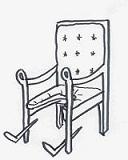
- Rise of scientific method
- Theories of the humors still much in vogue
- Science becomes popular, fashionable pursuit for women of upper classes
- Forceps publicized in 1733
- 1740’s: forceps popularized by Dr. Smellie, used by many without training or sanitary precautions
- Replacement of craniotomy with forceps reduced fear of male involvement
- More men involved in difficult cases, increasing view of childbirth as dangerous
- Doctors begin to see economic advantages in managing childbirth
- Midwives lose respect (not permitted same education, only a few learned forceps)
- Conservatives oppose “man-midwives” as unnatural and immoral
Practices
- Many births still under care of midwife (including children of George III)
- Doctors called in sooner; forceps saved some lives, speeded birth but in some cases led to complications, possibly fatal
- Upper class families began to rely on male doctors as primary caregivers
- Treatment still based on theories of the humors--fertility, pregnancy treated through lowering regimen (special diets), purging and bloodletting
- About mid-century, childbirth ritual changes among the upper classes
- Male physicians decry the dark, warm lying-in chamber, advocate a bright, airy birthing chamber to ward off puerperal fever
- Prohibit laboring woman to drink caudle (attendants still do)
- Birthing chairs become more specialized, higher for ease of attendants, with handholds and footrests
- More births in special birthing beds (for those who could afford them)
- Sims position (woman on her side, knees curled up, facing away from doctor) touted as most modest as it avoids eye contact
- Husband might attend
- Decrease in practice of fostering children out
- Physicians advised women to breastfeed their own children; many did
- Month-long lying-in period still observed
- Women of means hired a monthly nurse to care for them
- Churching and christening follow
- Women of lower classes, more old-fashioned families still give birth the old way
- In colonial America, practices similar to Europe although “magical” practices died out quicker (Puritanism); midwives have better success, healthier women
Sources
Please click on the links below to access the relevant entries in the Bibliography.
Buchan, William, Domestic Medicine.
Cutter, Irving S., and Viets, Henry R., A Short History of Midwifery.
Dewhurst, Jack, Royal Confinements.
Gelis, Jacques, History of Childbirth: Fertility, Pregnancy and Birth in Early Modern Europe.
Leavitt, Judith Walzer, Brought to Bed: Childbearing in America 1750-1950.
Lewis, Judith Schneid, In the Family Way: Childbearing in the British Aristocracy, 1760-1860.
Sharp, Jane, Midwives Book: Or the Whole Art of Midwifery Discovered.
Wertz, Richard W. and Dorothy C., Lying-In: A History of Childbirth in America.
Williams, Guy, The Age of Agony, The Art of Healing, c 1700-1800.
Wilson, Adrian, The Making of Man-Midwifery: Childbirth in England, 1660-1770.


Attitudes and Developments
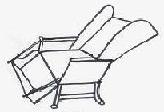
- Upper classes continue to want big families, healthy womenfolk
- Continued emphasis on development of “rational” science (still intermixed with classical theories)
- Continued campaign against “dirty and ignorant” midwives
- As male doctors see more normal cases, begin to view childbirth as a natural process again, a brief “back to nature” movement
- Return to more intervention in childbirth after tragedy in 1817:
- Princess Charlotte dies 5 hours after 50 hour labor and stillbirth, Britain mourns, blames Dr. Croft who later commits suicide
- Opponents of man-midwifery advocate return of female midwives
- Medical establishment reacts by advocating quicker use of forceps
- Concept of motherhood changing — decreased emphasis on birth vs. parenting
- Terminology of childbirth changing to increased euphemism: “breeding” becomes “in the family way”, “lying-in” becomes “confinement”
Practices
- Continued transition from traditional birth ritual to “scientific” childbirth
- Gentlemanly accoucheur now like the midwife: less invasive, more supportive
- Up until 1817, forceps less likely to be used than earlier in the 18th century
- After 1817, return to more aggressive measures in difficult births
- Many births, especially among lower classes, still managed the traditional way
- Transition of control of birth from midwife to male practitioner faster in America
Sources
Please click on the links below to access the relevant entries in the Bibliography.
Banks, Amanda Carson, Birth Chairs, Midwives and Medicine.
Buchan, William, Domestic Medicine.
Cutter, Irving S., and Viets, Henry R., A Short History of Midwifery.
Dewhurst, Jack, Royal Confinements.
Gelis, Jacques, History of Childbirth: Fertility, Pregnancy and Birth in Early Modern Europe.
Leavitt, Judith Walzer, Brought to Bed: Childbearing in America 1750-1950.
Lewis, Judith Schneid, In the Family Way: Childbearing in the British Aristocracy, 1760-1860.
Wertz, Richard W. and Dorothy C., Lying-In: A History of Childbirth in America.
Williams, Guy, The Age of Agony, The Art of Healing, c 1700-1800.
Wilson, Adrian, The Making of Man-Midwifery: Childbirth in England, 1660-1770.


Attitudes and Developments
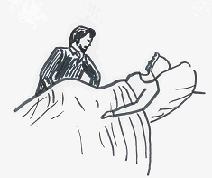
- Increasing view of ladies: fragile, too elevated to give birth in robust fashion
- Adverse affects of tight corseting and inactivity on women’s health
- Counter-trends: “Popular Health Movement”
- Early and unsuccessful attempts at return to natural childbirth
- Greater disassociation of motherhood with the physical birth process
- Pain relief becomes acceptable, even fashionable
- 1847 — ether used by Scottish physician James Simpson to treat labor pain
- 1853 — Queen Victoria uses it for birth of Prince Leopold, gives Simpson a baronetcy in gratitude for the “blessed chloroform”
- American women disappeared from the social scene when pregnant
- English women don't appear to have viewed pregnancy with as much shame
- Queen Victoria welcomed Lady Charlotte Guest (6 months pregnant) to a ball at the palace in 1840, Queen Victoria was pregnant herself
- Women being pushed out of science, though some rebel, becoming doctors
- Continuing campaign by doctors against midwives, especially in America--claims that women should not know “such things”
Practices
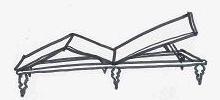
- Birth in bed, lithotomy position (lying down, knees up) becomes most favored
- Modesty preserved by maintaining eye contact (no view of genitals), doctors worked by touch alone
- “Chloroform and forceps” births become common, especially for women of upper classes
- Birth still mostly at home, chloroform might be administered by woman’s relatives, friends, servants or woman herself--no standardization
- Movement to exclude “unnecessary” persons from the scene
- Some women breastfed; some used wet-nurses, some babies fed “pap” (mix of bread and water, sugar, milk added later)
- Old rituals of childbirth continue among poor, in rural areas, but eroding
- Postpartum rest period becoming less common for working classes
- Caesarean section performed successfully in 1882, safer with the advent of aseptic/antiseptic measures
Sources
Please click on the links below to access the relevant entries in the Bibliography.
Banks, Amanda Carson, Birth Chairs, Midwives and Medicine.
Cutter, Irving S., and Viets, Henry R., A Short History of Midwifery.
Dewhurst, Jack, Royal Confinements.
Engelmann, George J., Labor Among Primitive Peoples
Gelis, Jacques, History of Childbirth: Fertility, Pregnancy and Birth in Early Modern Europe.
Leavitt, Judith Walzer, Brought to Bed: Childbearing in America 1750-1950.
Lewis, Judith Schneid, In the Family Way: Childbearing in the British Aristocracy, 1760-1860.
McMillen, Sally Gregory, Motherhood in the Old South: Pregnancy, Childbirth and Infant Rearing.
Wertz, Richard W. and Dorothy C., Lying-In: A History of Childbirth in America.

Miscellaneous Topics
-Activity and Dress During Pregnancy
- Throughout much of history, women continued usual activity, adapted existing dress styles--first maternity clothes in 1904
- Physicians usually advocated exercise, but women who miscarried might be blamed for having overexerted themselves
- “Bandages” or leather support girdles were sometimes worn to support abdomen
- Regency period: a maternity corset existed, though physicians advised against tight-lacing and high-waisted dresses were well-suited to pregnancy
- Victorian period: ladies often wore corsets half way through pregnancy, so they could hide their condition and continue normal activity
Sex During Pregnancy?
- Prohibited at times by religion, however…
- Medieval “sex manuals” sanctioned by the Church show recommended positions during pregnancy — the intent was to keep husbands from cheating
- Later some physicians warned against sex early or late in the pregnancy, or excessive sex at any time as being dangerous to the baby
- In a study of Regency and Victorian aristocratic women, some women thought they were pregnant for 10-14 months — must have conceived while they thought themselves pregnant
Hospital Birth
- Throughout most of history, vast majority of births were at home
- Lying-in hospitals or wards that existed were for charity and study
- Earliest hospitals on European continent
- 1739 -- first lying-in hospital in England
- Puerperal fever becomes a severe problem
- Some 18th century physicians advocate cleanliness, are scoffed at
- Simple sanitary measures were not always sufficient
- Early 19th century experiments with heat and chemical disinfection
- Fever in hospitals increased view of childbirth as catastrophic event
- Medical community resisted concept of contagion from birth attendants
- Respectable women did not give birth in a hospital (modesty, class consciousness, fear of puerperal fever)
- 19th century sees rise in lying-in hospitals in all countries (still for poor)
- 1880’s: aseptic/antiseptic methods developed and begin to be used
- Aggressive use of methods on all patients in hospitals
- Hospital birth becomes common in 1920’s and 1930’s with “Twilight Sleep”
Sources on Clothing
Please click on the links below to find references related to clothing for pregnant women, women giving birth, childbirth attendants, and infants.
Baumgarten, Linda, What Clothes Reveal: The Language of Clothing in Colonial and Federal America.
Cunnington, Phillis Emily, Costume for Births, Marriages and Deaths.

Bibliography
Banks, Amanda Carson, Birth Chairs, Midwives and Medicine, University Press of Mississippi, Jackson, 1999, ISBN: 1578061717, 1578061725. (A study of the evolution of birth chairs and birth positions, the role of midwives and the “medicalization” of childbirth.Scholarly feminist. Great pictures although as a Regency author I would prefer them to be more closely dated than, for example, “nineteenth century”.)
Baumgarten, Linda, What Clothes Reveal: The Language of Clothing in Colonial and Federal America, Colonial Williamsburg Foundation in association with Yale University Press, Williamsburg, Va., 2002, ISBN: 0879352167 (hardcover:alk.paper) 0300095805 (hardcover:alk.paper). (Contains some useful information on clothing during pregnancy, labor and post-partum, and for infants. Although this is about America, some of the information is applicable to Europe as well.)
Buchan, William, Domestic Medicine New York : Garland, 1985 (reprint, originally published: 2nd ed. London : Printed for W. Strahan, 1772), ISBN: 082405931X (alk. paper). (Book on general medicine, intended to educate lay persons as well as medical practitioners. Has a section “On the Diseases of Women” which deals with menstruation, pregnancy, childbirth and barrenness. A mix of common sense (such as advising women to put their babies to breast early) and typical eighteenth century medical practices, such as bloodletting. The section on childbirth contains much advice on postpartum care but less about delivery itself.)
Bull, Thomas, Hints to Mothers, For the Management of Health During the Period of Pregnancy, and in the Lying-in Room: with an Exposure of Popular Errors in Connexion with those Subjects and Hints Upon Nursing, Wiley & Putnam, New York, 1877. (A Victorian “What to Expect When You’re Expecting” Covers health during pregnancy, determining pregnancy, “diseases” of pregnancy, prevention of miscarriage, determining the due date, delivery, postpartum care of mother and child, and breastfeeding. Interesting. He cautions against self-administration of chloroform.)
Caton, Donald, What a Blessing She Had Chloroform: The Medical Response to the Pain of Childbirth from 1800 to the Present, Yale University Press, 1999, ISBN: 0300075979. (Written by an anesthesiologist. Though the subtitle indicates 1800 as the start of the period covered, the coverage really starts with 1847, when ether was first used for labor pain. Lots of good information on attitudes toward and treatment of labor pain from that point to the present. His insights are interesting. He seems to deny that doctors ever supported pain-relieving drugs for fame or monetary gain, which I have difficulty believing. However, I don’t doubt that some of the pioneers in this field truly wanted to alleviate women’s suffering, or that women themselves provided a lot of the impetus for the movement.)
Cunnington, Phillis Emily, Costume for Births, Marriages and Deaths, Barnes & Noble, New York, 1972, ISBN: 0064913376. (Has three relevant chapters: 1. Births — mother and attendants, 2. The Baby, and 3. The Christening. Has some information on what was worn during pregnancy, ex., corseting, what was worn during labor by mother and birth attendants (early man-midwives donned nightgowns over their clothing to make their patients more comfortable!), clothing for breastfeeding, how babies were fitted out and the pomp associated with christenings of upper-class babies.)
Cutter, Irving S., and Viets, Henry R., A Short History of Midwifery, W. B. Saunders Company, Philadelphia and London, 1964. (Not, as it might appear, a history of female midwives. This is really a history of obstetrics, with excerpts from period writings on the subject dating from 1560 onward. It’s heavy reading, and the author seems to accept writings of male physicians ridiculing midwives without considering the writers’ motives. But also has a lot of obscure medical history—some many of us would rather not know, perhaps.)
Demand, Nancy, Birth, Death, and Motherhood in Classical Greece, Johns Hopkins University Press, Baltimore and London, 1994, ISBN: 0-8018-4762-1. (Some details on childbirth and pregnancy, focus on society and gender roles.)
Dewhurst, Jack, Royal Confinements, Weidenfeld and Nicolson, 1980, ISBN: 0297778471. (Describes confinements of British royalty from the Stewarts to Victoria and Albert. Includes interesting details on both social and medical aspects, including diet, medicines and practices used. Good insights into what was “best practice” for the relevant time periods.)
Eccles, Audrey, Obstetrics and Gynaecology in Tudor and Stuart England, Croom Helm, London, 1982. (Not a long book, but a good basic reference on the beliefs and practices of the periods covered with some interesting observations.)
Engelmann, George J., Labor Among Primitive Peoples, J. H. Chambers & Co., St. Louis, 1882. (Comments: Early study of upright postures used during labor and other pregnancy and childbirth practices among the “uncivilized”. The author hoped this would encourage society and the obstetric community to consider adopting some of these more natural practices, but the general response was that civilized women, especially those of the upper classes, were too delicate due to overindulgence, inactivity and corseting) to be able to give birth as “savages” did, and therefore in especial need of the services of modern obstetrics: to be delivered lying down, anesthetized and with the aid of instruments.)
Flemming, Rebecca, Medicine and the Making of Roman Women: Gender, Nature, and Authority from Celsus to Galen, Oxford University Press, New York, 2000, ISBN: 0199240027. (Scholarly study of Roman women’s roles both as patients and as medical practitioners; includes information on sexuality, pregnancy, childbirth, midwives.)
Gelis, Jacques, History of Childbirth: Fertility, Pregnancy and Birth in Early Modern Europe, Northeastern University Press, Boston, 1991, ISBN: 1555531024, 1555531059. (Detailed and respectful study of the “unwritten” history of childbirth: folklore, traditional practices, “old wives’ tales”. Author unflinchingly explores ancient beliefs and inner fears and concerns about childbirth and how these evolved into the early modern period. Much of it is universal, but please note it is a translation from the French and draws largely on examples within France.
Ghalioungui, Paul, The Physicians of Pharaonic Egypt, Cairo, A.R.E. : Al-Ahram Center for Scientific Translations ; Springfield, Va. : Available from the U.S. Dept. of Commerce, National Technical Information Service, 1983, ISBN: 3805306008. (A study of physicians listed in extant sources. Most notable for its lack of information on childbirth attendants. Although midwives are depicted in other sources, no midwives are listed by name. One female doctor was listed, but there is no evidence that female doctors specialized in women’s health.)
Ghalioungui, Paul, Magic and Medical Science in Ancient Egypt, Hodder and Stoughton, London, 1963. (The chapter on specialists includes about 9 pages of useful information on pregnancy and childbirth.)
Green, Monica H., The Trotula: A Medieval Compendium of Women’s Medicine, University of Pennsylvania Press, Philadelphia, 2001, ISBN: 0812235894. (A group of influential texts on women’s medicine which originated in 11th or 12th century Salerno, Italy, at times attributed to a medieval woman named Trotula or Trota. This translator believes there were three authors involved in three texts which were later combined. The introductory material is interesting, as are the three texts: On the Conditions of Women, On Treatments for Women, and On Women’s Cosmetics, covering topics including menstruation, fertility, pregnancy and childbirth among others. Fascinating. There are even recipes for feigning virginity.
Leavitt, Judith Walzer, Brought to Bed: Childbearing in America 1750-1950, Oxford University Press, New York, 1986, ISBN: 0195038436 (alk. paper). (Similar in coverage to the Wertz book, described below. A good general reference for the period covered.)
Lewis, Judith Schneid, In the Family Way: Childbearing in the British Aristocracy, 1760-1860, Rutgers University Press, New Brunswick, New Jersey, 1986, ISBN: 0-8135-1116-X. (A study of the reproductive experiences of fifty ladies, including information from their letters and journals. Good analysis of the trends of the time, along with great tidbits and stories of famous ladies including Lady Caroline Lamb, Lady Jersey, Princess Charlotte and Queen Victoria. Perfect for the Regency author.)
McMillen, Sally Gregory, Motherhood in the Old South: Pregnancy, Childbirth and Infant Rearing, Louisiana State University Press, 1990, ISBN: 0807115177. (What with the emphasis on large families, the heat, the malaria, corsets, medical practices that heavily featured the use of mercury and opium, it seems like a miracle that any of these women and their babies survived. But depressing aspects aside, this is an excellent reference for writers using this setting, including many examples and quotes from period diaries and letters.)
Musacchio, Jacqueline Marie, The Art and Ritual of Childbirth in Renaissance Italy, Yale University Press, 1999, ISBN: 0300076290. (Beautifully illustrated book on the objects associated with the celebration of childbirth, including painted trays, ceramic objects, etc…, from an artistic but also social/historical viewpoint. Includes a glossary of Italian Renaissance terms associated with childbirth and useful information on the practices and customs. A must for anyone writing in this unusual setting.)
Sharp, Jane, Midwives Book: Or the Whole Art of Midwifery Discovered, Oxford University Press, New York, 1999, ISBN:nbsp;019508652X (alk. paper) 0195086538 (pbk.:alk.paper). (A treatise written by a woman, published in 1671, reissued in 1724 and 1725. Consists of 6 “books” covering anatomy, conception, barrenness, recognizing the signs of labor, management of labor, postpartum care of mother and baby. The author drew on earlier male sources, including Culpeper’s Directory for Midwives, but with changes that indicate a more matter-of-fact and sympathetic attitude toward women’s sexuality. A fascinating primary source.)
Soranus of Ephesus, Gynecology, Translated with an introd. by Owsei Temkin, Baltimore, Johns Hopkins Press, 1956. (Treatise by 1st-2nd century Greek physician that was influential until the 16th century (arguably beyond). An interesting and sometimes frightening primary source.)
Ulrich, Laurel Thatcher, A Midwife’s Tale: The Life of Martha Ballard, Based on her Diary, 1785-1812, Knopf, New York, 1990, ISBN: 0394568443. (Pulitzer Prize winning story of an everyday heroine in Maine. Martha Ballard delivered babies, grew and dispensed medicinal herbs, viewed autopsies and prepared bodies for burial, in addition to being a wife, mother and grandmother. During the time covered by her diary she assisted at 814 deliveries (of nearly 1000 during her lifetime), at times crossing frozen rivers or wading through hip-deep snowdrifts to get to her patients. She lost only 5 mothers, none during delivery. The souls of doctors who decried “dirty and ignorant midwives” should beg Martha’s forgiveness. Lots of insights into early American life and society, and the role of women healers. Most of the medical detail is in chapter 5 and 7, but if you have time this book is worth reading cover-to-cover.)
Wertz, Richard W. and Dorothy C., Lying-In: A History of Childbirth in America, Yale University Press, New Haven and London, 1989, ISBN: 0-300-04088-1 (cloth), 0-300-04087-3 (pbk). (Covers colonial times to the 1980’s. A detailed, useful reference.)
Williams, Guy, The Age of Agony, The Art of Healing, c 1700-1800, Academy Chicago Publishers, Chicago, Illinois, 1975, ISBN: 0-89733-202-4, 0-89733-203-2 (pbk.). (Chapter 3 is titled “The Perils of Pregnancy and Birth in the Eighteenth Century”. It has some interesting information, including an account of the Chamberlens and the popularization of the forceps and the hoax involving Mary Tofts, who claimed to give birth to rabbits. It also contains other useful information on the medical developments of the time, but in his zeal to expound on the theme of the horrors of 18th century medicine (and it truly was horrible) the author draws heavily on the writings of the newly rising man-midwives, who certainly had some agenda in discrediting the practice of female midwives and traditional rituals of childbirth.)
Wilson, Adrian, The Making of Man-Midwifery: Childbirth in England, 1660-1770, Harvard University Press, Cambridge, Mass., 1995, ISBN: 0-674-54323-8. (History of how medical men gradually took over from midwives and the ancient birth rituals gave way to modern practices. I found it scholarly but quite readable.)

Portrait by Oakdale Images
Elena Greene is a a participant in the Amazon Services LLC Associates Program, an affiliate advertising program designed to provide a means for sites to earn advertising fees by advertising and linking to amazon.com.
Copyright © 2015, Elena Greene. All rights reserved.